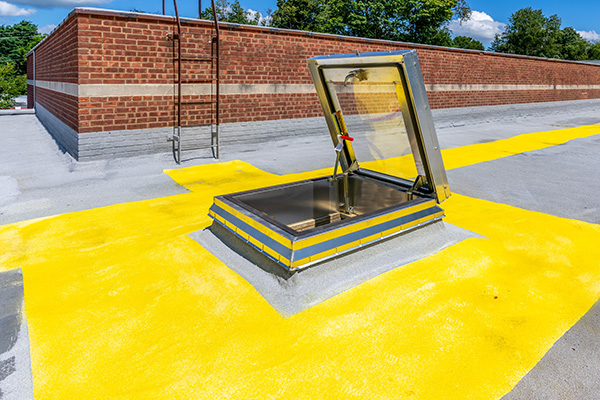Commercial Roof Safety: Maintaining Proper Roof Hatches and Safety Rails
Author: Dan Stout | August 7, 2024
Most roofing contractors are safety-conscious and know the typical risks when they're up on a roof. But competency can result in complacency, especially when a safety risk isn't immediately apparent.

It's easy to be aware of roofing safety while on a ladder or steep-pitch roof, or when walking along a roof's edge. Staring at a long drop has a way of boosting our sense of self-preservation. But large, low-slope roofs just feel safe, as if we're already standing on solid ground. While it's true that they're safer than steep-slope roof work, that doesn't mean there's no risk at all. And one of the most common sources of danger on commercial roofing jobs comes from a surprising source: the roof hatch.
What Is a Roof Hatch?
Hatches allow direct access to unoccupied roofs (defined by the International Building Code as a roof that is not accessible to occupants on a regular basis — so without recreation areas, swimming pools or other features that would cause it to be treated as a standard living area). They're typically accessed by a ladder or stairwell. They can be single- or double-leaf openings and come in a range of sizes.
Anyone who uses a roof hatch once will immediately recognize how convenient they are. They allow for quick rooftop access without exterior ladders or scaffolds, which is especially useful for maintenance and inspections. They're also very low-profile, practically blending into the landscape of a commercial roof.
What Risks Are Associated with Roof Hatches?
The primary issue with roof hatches is a result of how well they blend in with the background: It's easy to forget they're there. And forgetting about a hole in the roof can be a big issue.
It's common for crews to leave roof hatches open while loading material onto a roof, resulting in what is essentially a big hole in the roof. Open roof hatches are fall hazards, especially for workers walking backward, whether unrolling material or carrying heavy objects with a coworker.
How to Secure a Roof Hatch
Documents such as OHSA 1910.28(b)(3) and ANSI/ASSE A1264.1-2017 exist to help ensure employee safety when they're on the job — and contain information on the risks of roof hatches and how to protect workers from danger.
The preferred way to secure a roof hatch is with a dedicated guardrail. A guardrail has two fixed sides and one self-closing gate. The fourth side typically isn't needed, as the open hatch itself creates a barrier.
When a client's hatches don't have guardrails, you'll need to decide how to proceed. If you're installing a new roof, this is pretty straightforward: Include guardrail installation in the estimate. But when doing smaller maintenance work, there's a good chance a client won't be interested in the added expense. In this case, you'll have to decide the best course of action.
One option is simply to close the hatch immediately upon entering the roof. Unfortunately, if this pops up on OSHA's radar, you may be the one hit with a penalty. To keep on the right side of the government, be sure you can document the following steps: Ask the property owner to correct the situation, inform your workers of the potential hazard and take appropriate action to mitigate the risk. Ultimately, if the risk of injury is too high, you'll need to pull workers off the job.
Sometimes a client just isn't interested in paying for proper protection. They may drag their feet or try to put the responsibility on your shoulders. You may even get the feeling that they're trying to get you to install a free set of guardrails. In that case, remember that most hatch guardrails are designed to not penetrate the roof membrane. This means you can always install guardrails while on the job, then uninstall them and take them with you after the job is over.
No matter what solution you settle on, it's essential to take roof hatch safety into account on a commercial jobsite. Check with a trusted vendor to make sure you're using the best guardrails for your specific situation.